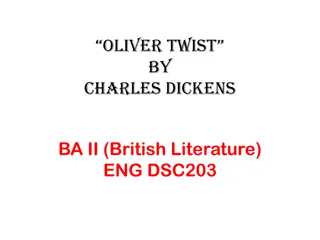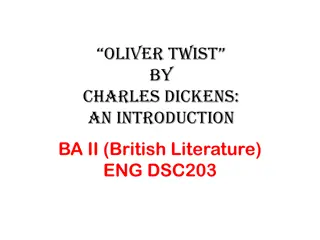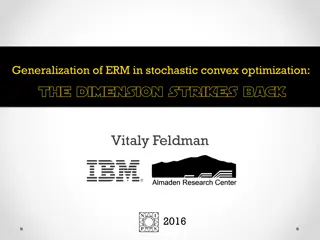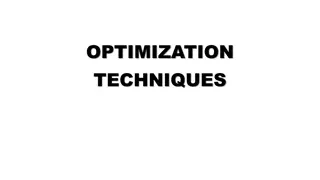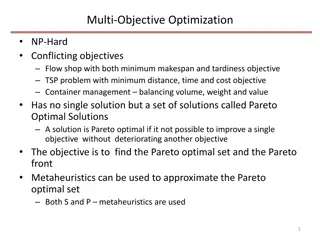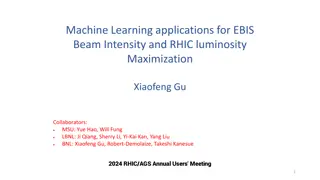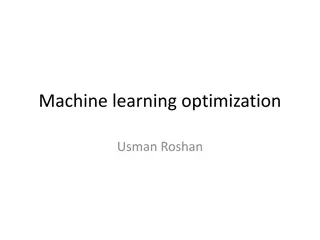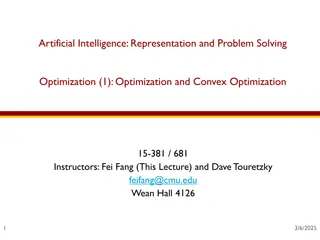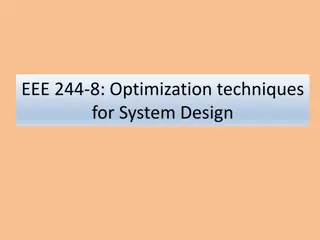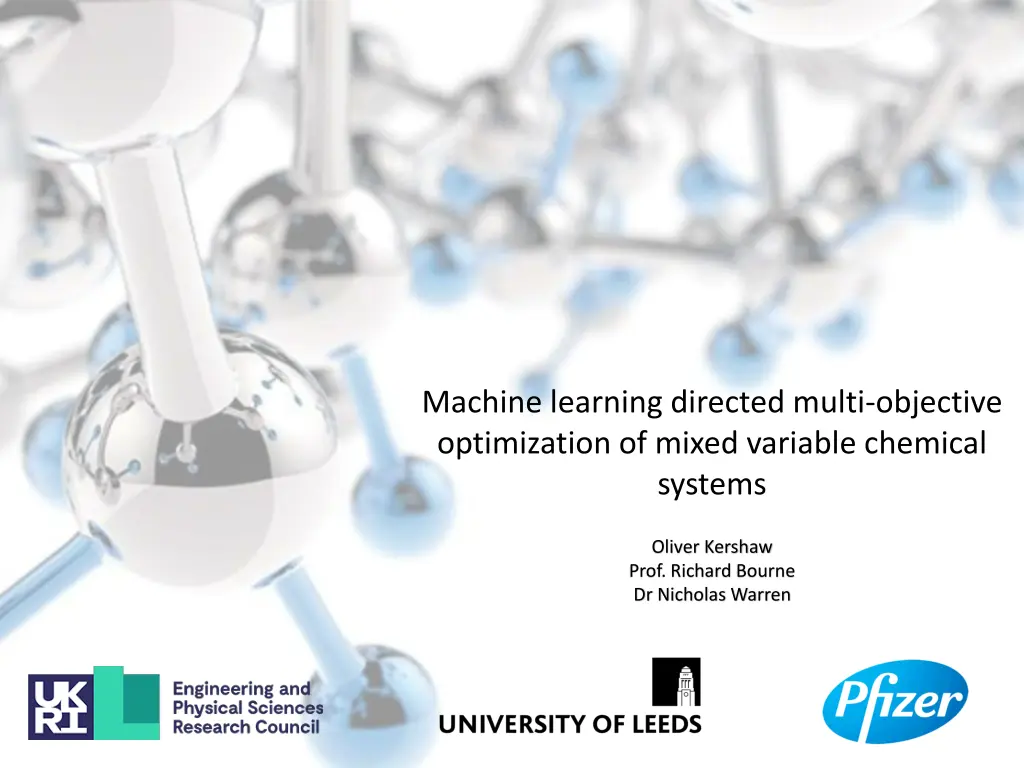
Chemical Systems Multi-Objective Optimization
Focusing on the application of Machine Learning Directed Multi-Objective Optimization in mixed variable chemical systems, this research by Oliver Kershaw, Prof. Richard Bourne, and Dr. Nicholas Warren aims to autonomously optimize the manufacturing of APIs by simultaneously optimizing categorical and continuous variables on continuous flow systems using the MVMOO algorithm. The study explores interactions between variables, with a specific focus on solvent optimization and Sonogashira coupling reactions. The findings showcase the algorithm's capability to identify and manipulate mixed variable interactions to maximize selected objectives, highlighting counterintuitive trends and the advantages of these optimizations.
Download Presentation

Please find below an Image/Link to download the presentation.
The content on the website is provided AS IS for your information and personal use only. It may not be sold, licensed, or shared on other websites without obtaining consent from the author. If you encounter any issues during the download, it is possible that the publisher has removed the file from their server.
You are allowed to download the files provided on this website for personal or commercial use, subject to the condition that they are used lawfully. All files are the property of their respective owners.
The content on the website is provided AS IS for your information and personal use only. It may not be sold, licensed, or shared on other websites without obtaining consent from the author.
E N D
Presentation Transcript
Machine learning directed multi-objective optimization of mixed variable chemical systems Oliver Kershaw Prof. Richard Bourne Dr Nicholas Warren
School of Chemical and Process Engineering FACULTY OF MATHEMATICS AND PHYSICAL SCIENCES Mixed variable optimisation AIM: Simultaneous optimisation of categorical and continuous variables on automated continuous flow systems Autonomously optimise chemical systems for the manufacture of APIs Utilises Mixed Variable Multi-Objective Optimisation (MVMOO) algorithm (available through github) Allows full variable interactions to be studied [1] J.A. Manson, T.W. Chamberlain, R.A. Bourne, MVMOO: Mixed variable multi-objective optimisation, J. Glob. Optim. 2021, 80, 865 886. https://github.com/jmanson377/MVMOO 2
School of Chemical and Process Engineering FACULTY OF MATHEMATICS AND PHYSICAL SCIENCES Solvent Optimisation 6-port switching valve utilised for discrete variable selection Optimisation completed in 18 hours mapping Pareto front sufficiently, observing known solvent effects [3] [2] A. M. Schweidtmann, A. D. Clayton, N. Holmes, E. Bradford, R. A. Bourne and A. A. Lapkin, Chem. Eng. J., 2018, 352, 277 282. [3] Internals of vici selection valves. Available from: https://www.vici.com/cval/images/c5-schem.jpg [4] O.J. Kershaw, A.D. Clayton, J.A. Manson, A. Barthelme, J. Pavey, P. Peach, J. Mustakis, R.M. Howard, T.W. Chamberlain, N.J. Warren, R.A. Bourne, Chem. Eng. J., 2023, 451,138443. 3
School of Chemical and Process Engineering FACULTY OF MATHEMATICS AND PHYSICAL SCIENCES Sonogashira Coupling 69 reactions completed over a 22h time period Achieved an impressive overall 90% yield (corresponding to highest RME experiment) Hypervolume monitored after 60 experiments, terminated once plateau was observed [4] O.J. Kershaw, A.D. Clayton, J.A. Manson, A. Barthelme, J. Pavey, P. Peach, J. Mustakis, R.M. Howard, T.W. Chamberlain, N.J. Warren, R.A. Bourne, Chem. Eng. J., 2023, 451,138443. [5] S. Yu, A. Haight, B. Kotecki, L. Wang, K. Lukin and D. R. Hill, J. Org. Chem., 2009, 74, 9539 9542. [6] A. D. Clayton, A. M. Schweidtmann, G. Clemens, J. A. Manson, C. J. Taylor, C. G. Ni o, T. W. Chamberlain, N. Kapur, A. J. Blacker, A. A. Lapkin and R. A. Bourne, Chem. Eng. J., 2020, 384, 123340. 4
School of Chemical and Process Engineering FACULTY OF MATHEMATICS AND PHYSICAL SCIENCES Sonogashira Coupling Mapped the Pareto front with 17% of experimental points making up the front Optimisation results highlight trends that are counterintuitive based on chemical understanding, highlighting advantages of these optimisations Highlights algorithms ability to identify and manipulate the mixed variable interactions to maximise selected objectives [4] O.J. Kershaw, A.D. Clayton, J.A. Manson, A. Barthelme, J. Pavey, P. Peach, J. Mustakis, R.M. Howard, T.W. Chamberlain, N.J. Warren, R.A. Bourne, Chem. Eng. J., 2023, 451,138443. [5] S. Yu, A. Haight, B. Kotecki, L. Wang, K. Lukin and D. R. Hill, J. Org. Chem., 2009, 74, 9539 9542. [6] A. D. Clayton, A. M. Schweidtmann, G. Clemens, J. A. Manson, C. J. Taylor, C. G. Ni o, T. W. Chamberlain, N. Kapur, A. J. Blacker, A. A. Lapkin and R. A. Bourne, Chem. Eng. J., 2020, 384, 123340. 5



